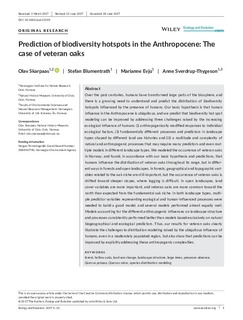| dc.description.abstract | Over the past centuries, humans have transformed large parts of the biosphere, and there is a growing need to understand and predict the distribution of biodiversity hotspots influenced by the presence of humans. Our basic hypothesis is that human influence in the Anthropocene is ubiquitous, and we predict that biodiversity hot spot modeling can be improved by addressing three challenges raised by the increasing ecological influence of humans: (i) anthropogenically modified responses to individual ecological factors, (ii) fundamentally different processes and predictors in landscape types shaped by different land use histories and (iii) a multitude and complexity of natural and anthropogenic processes that may require many predictors and even multiple models in different landscape types. We modeled the occurrence of veteran oaks in Norway, and found, in accordance with our basic hypothesis and predictions, that humans influence the distribution of veteran oaks throughout its range, but in different ways in forests and open landscapes. In forests, geographical and topographic variables related to the oak niche are still important, but the occurrence of veteran oaks is shifted toward steeper slopes, where logging is difficult. In open landscapes, land cover variables are more important, and veteran oaks are more common toward the north than expected from the fundamental oak niche. In both landscape types, multiple predictor variables representing ecological and human-influenced processes were needed to build a good model, and several models performed almost equally well. Models accounting for the different anthropogenic influences on landscape structure and processes consistently performed better than models based exclusively on natural biogeographical and ecological predictors. Thus, our results for veteran oaks clearly illustrate the challenges to distribution modeling raised by the ubiquitous influence of humans, even in a moderately populated region, but also show that predictions can be improved by explicitly addressing these anthropogenic complexities. | nb_NO |

